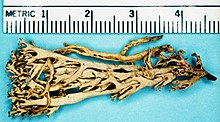| Cladonia alaskana | |
|---|---|

| |
|
Scientific classification
| |
| Domain: | Eukaryota |
| Kingdom: | Fungi |
| Division: | Ascomycota |
| Class: | Lecanoromycetes |
| Order: | Lecanorales |
| Family: | Cladoniaceae |
| Genus: | Cladonia |
| Species: | C. alaskana
|
| Binomial name | |
| Cladonia alaskana A.Evans, 1949
| |
Cladonia alaskana, commonly known as the Alaskan cup lichen, [1] is a species of cup lichen in the Cladoniaceae family. It is found in and around the arctic circle, [2] growing in acidic soils. [3] [4] 40-80 mm tall and up to 2 mm in diameter. This species grows over boulders in heath and tussock tundras. [5] [6]
References
- ^ "Standardized Common Names for Wild Species in Canada". National General Status Working Group. 2020.
-
^ M., Brodo, Irwin (2001).
Lichens of North America. Yale University Press.
ISBN
0-300-08249-5.
OCLC
45100151.
{{ cite book}}: CS1 maint: multiple names: authors list ( link) - ^ "Search". www.gbif.org. Retrieved 2020-09-23.
- ^ "Alaskan cup lichen data - Encyclopedia of Life". eol.org. Retrieved 2020-09-23.
- ^ Allen, Jessica L.; McMullin, R. Troy (2021-11-12). "Lichens and Allied Fungi of the North Fork Nooksack River Valley Bottom, Whatcom County, Washington: Important Biodiversity in a High-Use Area". Western North American Naturalist. 81 (4). doi: 10.3398/064.081.0403. ISSN 1527-0904.
- ^ Ammirati, Joseph F.; Thompson, John W. (1986). "American Arctic Lichens. I. The Macrolichens". Systematic Botany. 11 (1): 55. doi: 10.2307/2418946. ISSN 0363-6445.
| Cladonia alaskana | |
|---|---|

| |
|
Scientific classification
| |
| Domain: | Eukaryota |
| Kingdom: | Fungi |
| Division: | Ascomycota |
| Class: | Lecanoromycetes |
| Order: | Lecanorales |
| Family: | Cladoniaceae |
| Genus: | Cladonia |
| Species: | C. alaskana
|
| Binomial name | |
| Cladonia alaskana A.Evans, 1949
| |
Cladonia alaskana, commonly known as the Alaskan cup lichen, [1] is a species of cup lichen in the Cladoniaceae family. It is found in and around the arctic circle, [2] growing in acidic soils. [3] [4] 40-80 mm tall and up to 2 mm in diameter. This species grows over boulders in heath and tussock tundras. [5] [6]
References
- ^ "Standardized Common Names for Wild Species in Canada". National General Status Working Group. 2020.
-
^ M., Brodo, Irwin (2001).
Lichens of North America. Yale University Press.
ISBN
0-300-08249-5.
OCLC
45100151.
{{ cite book}}: CS1 maint: multiple names: authors list ( link) - ^ "Search". www.gbif.org. Retrieved 2020-09-23.
- ^ "Alaskan cup lichen data - Encyclopedia of Life". eol.org. Retrieved 2020-09-23.
- ^ Allen, Jessica L.; McMullin, R. Troy (2021-11-12). "Lichens and Allied Fungi of the North Fork Nooksack River Valley Bottom, Whatcom County, Washington: Important Biodiversity in a High-Use Area". Western North American Naturalist. 81 (4). doi: 10.3398/064.081.0403. ISSN 1527-0904.
- ^ Ammirati, Joseph F.; Thompson, John W. (1986). "American Arctic Lichens. I. The Macrolichens". Systematic Botany. 11 (1): 55. doi: 10.2307/2418946. ISSN 0363-6445.